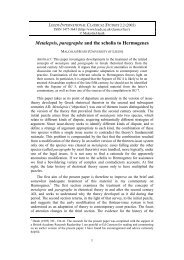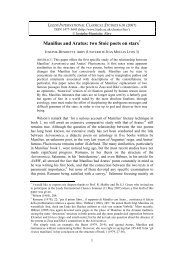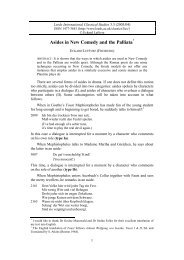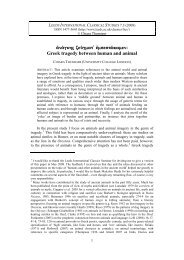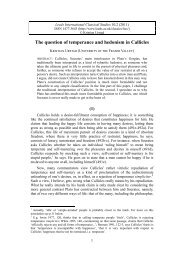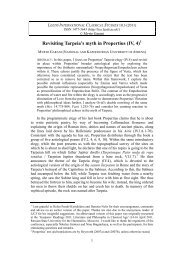The New Posidippus - Leeds International Classical Studies
The New Posidippus - Leeds International Classical Studies
The New Posidippus - Leeds International Classical Studies
You also want an ePaper? Increase the reach of your titles
YUMPU automatically turns print PDFs into web optimized ePapers that Google loves.
MARY FRANCES WILLIAMS, THE NEW POSIDIPPUS<br />
form is similar to that from a real body (Pol. 8.5, 1340a23-5), he implies that the<br />
mimetic aspect of sculpture and painting is ‘iconic’ and requires a direct<br />
correspondence of likeness. 14 Aristotle also believed that realistic mimesis<br />
provides more pleasure than abstract art. 15 <strong>Posidippus</strong> echoes Aristotle throughout<br />
his poems on sculpture in his interest in realism, his distinction between the heroic<br />
and the realistic; the relation between action and character; the importance of<br />
realistically depicting ‘better people’; interest in idealized realism; linkage<br />
between form and material, and emphasis on the visual. 16<br />
<strong>Posidippus</strong>’ reference to mimesis in poetry in relation to fine art is unique in<br />
Hellenistic poetry since mimesis never denotes poetic realism, or ecphrastic<br />
poetry, or fine art in Alexandrian poetry, and the word is not used in Hellenistic<br />
poetic theory. Zanker remarks, ‘the important thing ... is that mimesis and its<br />
congeners are never used to denote literary pictorialism [in Hellenistic authors]’.<br />
Zanker also declares that Aristotle’s form of mimesis is not important for<br />
Alexandrian poetic realism. 17 <strong>Posidippus</strong>’ poetry, however, contradicts this<br />
statement. His first poem is programmatic for the rest of the poems on sculpture in<br />
its emphasis on realism and its interest in rules with respect to fine art. 18<br />
<strong>Posidippus</strong>’ reference to mimesis is also programmatic since all of the poems are<br />
concerned with accurate artistic representations.<br />
<strong>Posidippus</strong>’ epigrams on sculpture are some of the first surviving expressions<br />
of art theory in the Hellenistic period and the first that are presented in verse. 19<br />
<strong>The</strong> use of a series of interconnected epigrams to formulate a coherent aesthetic<br />
theory for Hellenistic sculpture is exceptional. No treatises on art survive from<br />
before the first century BC, 20 and critical writings on art were rare: the fifth-<br />
14<br />
Cf. Arist. EN 6.4, 1140a10. Halliwell (2002) 162-3. Butcher (1898) 124-7, 153.<br />
15<br />
Arist. Poet. 6, 1450b1-4; Webster (1952) 14.<br />
16<br />
Lysippus and Aristotle had a similar artistic outlook. See Stewart (1990) I, 81, 187 and<br />
Schweitzer (1934) 291 on the relationship between Lysippus and Aristotle.<br />
17<br />
Zanker (1987) 39. Although Halliwell (2002) 264-5 declares that ‘by the Hellenistic period the<br />
vocabulary of mimeticism had become part of the lingua franca of Greek criticism and<br />
philosophical aesthetics’, he insists that the Poetics was little known in the Hellenistic period. It is<br />
possible that, instead of having direct knowledge of Aristotle’s theories, <strong>Posidippus</strong> was influenced<br />
by a broader tradition of which we have no first-hand evidence. However, Aristotle’s ideas about<br />
art are contained in a number of his works. Halliwell acknowledges the influence of Plato and<br />
Aristotle on Hellenistic mimeticism (ibid. 289), and Goldhill is open to a relationship between<br />
mimesis and Hellenistic literature, although he says that the relation between Hellenistic<br />
philosophy and literature has been ‘regrettably marginalised in the scholarly literature’ (Goldhill<br />
(1994) 207). I have found no examples of in archaic or classical inscriptional epigrams<br />
and only one instance in a fourth-century sepulchral inscription, where it does not refer to artistic<br />
mimesis (P.A. Hansen, Carmina Epigraphica Graeca Saeculi IV a. Chr. n. (Berlin & NY 1989),<br />
553 (ca. 350 Attica)).<br />
18<br />
Gutzwiller (2002a) 7.<br />
19<br />
Gelzer (1985) 99, 109-10 argues that some art theory is present ‘in disguise’ in Herondas Mim. 4<br />
(see pp.8, 13, 15 below).<br />
20<br />
Pollitt (1974) 9. But there were probably discussions among the sophists about mimesis and<br />
visual art in the fifth century (Halliwell (2002) 120-1). In the early Hellenistic period Duris of<br />
Samos apparently wrote on mimesis in historiography and art history (Duris FGrH 76F1; Duris<br />
FGrH 76 F89; Halliwell (2002) 289-91 & ns.11-13; Jex-Blake and Sellers (1896) xlvi-xlvii;<br />
Fornara (1983) 124-30).<br />
3



